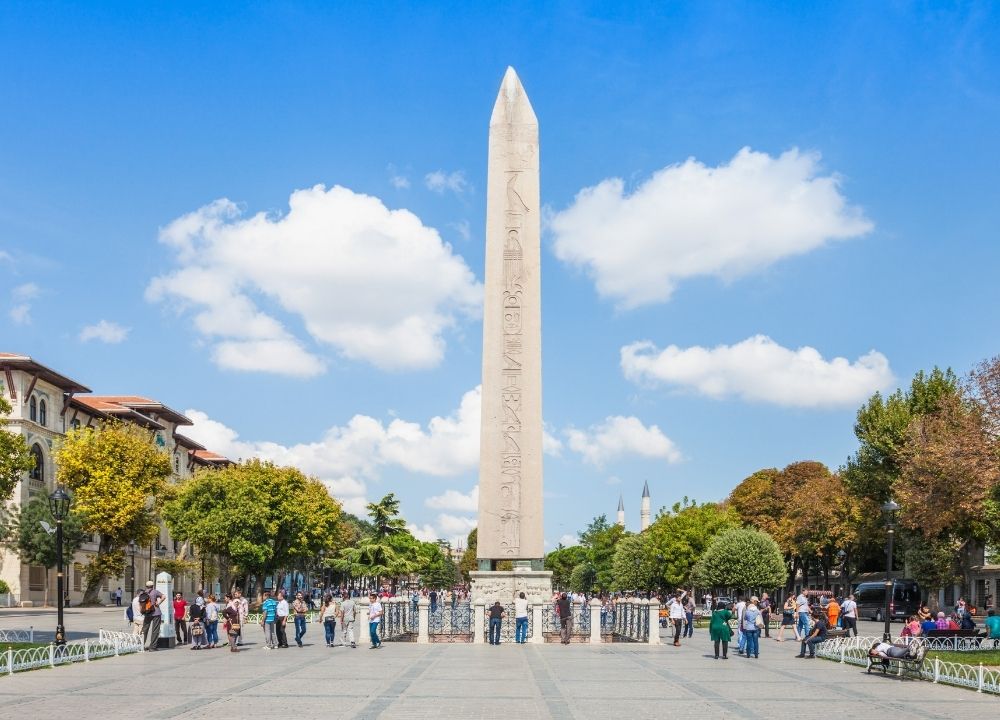Obelisks and Columns of Sultanahmet Square

The Sultanahmet Square, one of the historical riches of Istanbul, is home to three important buildings from the Roman and Byzantine periods: Theodosius Obelisk, Serpent Column and Walled Obelisk. These monuments hold an important place in Istanbul's cultural heritage with their architectural features and the historical and legendary stories they carry. Each one marks a different era and event, offering visitors traces of the past.
Theodosius Obelisk
Location and Structure:
The Theodosius Obelisk rises in the center of Sultanahmet Square. This monument was taken from the Temple of Amun-Ra in Luxor, Egypt and erected by Pharaoh Thutmose III in the 15th century BC. Emperor Theodosius I brought this monument to Istanbul in the 4th century and erected it in its present location in 390. The obelisk is about 19.6 meters high, made of red granite and decorated with hieroglyphic inscriptions. On the stone are reliefs depicting the pharaoh's victories to the gods.
Story and Legends:
The Obelisk of Theodosius is notable not only for its architecture, but also for the events that took place during the process of bringing the stone to Istanbul and erecting it in its place. According to legend, bringing the obelisk to Istanbul was considered a great engineering feat. Moreover, on the marble base used to erect the stone in Sultanahmet Square, there are reliefs depicting the erection of the obelisk. These reliefs reveal the technical knowledge and craftsmanship of that period.
Serpent Column
Location and Structure:
The Serpent Column is located in Sultanahmet Square, near the Obelisk of Theodosius. This column was built in the 5th century BC for the Temple of Apollo in Delphi to commemorate the victory of the Greek city-states against the Persians. This 8 meter high bronze column is shaped like three snakes wrapped around each other. When it was brought to Istanbul, the snake heads were still present, but today only the body remains.
Story and Legends:
One of the most interesting aspects of the Serpent Column is its symbolic meaning and legends. Snake figures have been accepted as a symbol of victory and protection from evil. When it was brought to Istanbul, it was believed to protect the city from evil spirits and enemies. Until the 17th century, the snake heads of the column were intact, but according to some rumors, they were broken by a janissary during the Ottoman period. This event has been the subject of various stories among the people.
Walled Obelisk
Location and Structure:
The Walled Obelisk is located in the southern part of Sultanahmet Square and attracts less attention than the other two columns. It is approximately 32 meters high and was built by Byzantine Emperor Constantine VII in the 10th century. The column was built by stacking cut stones on top of each other and was named “Walled Obelisk” because of this feature.
Story and Legends:
It is known that the stones used in the construction of the Walled Obelisk were decorated with sculptures symbolizing various victories of the Byzantine Empire. However, these decorations have been lost or destroyed over time. The original height of the Walled Obelisk and the details of the sculptures at the top have been the subject of various rumors throughout history. This monument was considered an important structure symbolizing the power and victories of Byzantium.
The Theodosius Obelisk, the Serpent Column and the Walled Obelisk are precious monuments that shed light on the history of Istanbul. Each of them is a unique part of Sultanahmet Square with its own story, structure and legends. These structures are a must-see for those who want to explore Istanbul's rich historical and cultural heritage.


